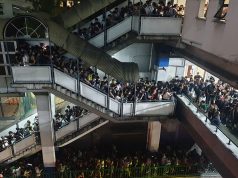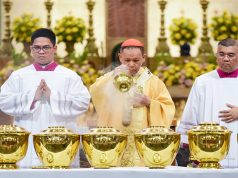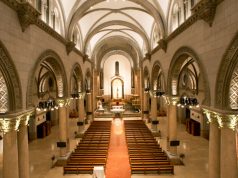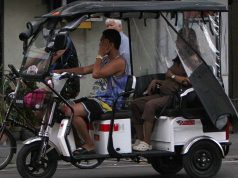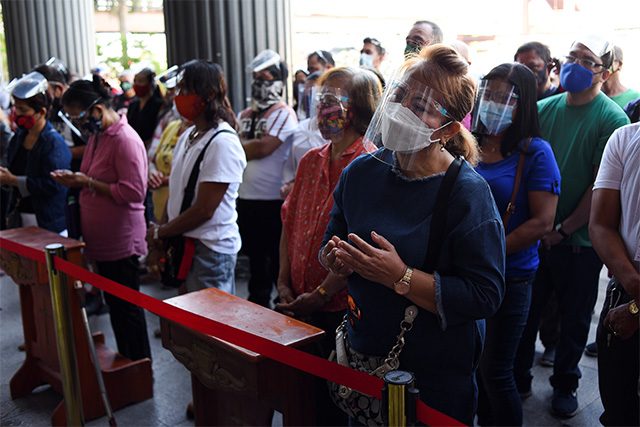
Different churches released advisories informing their parishioners of the cancelation of physical masses after the government backtracked its previous announcement that Metro Manila will be placed under general community quarantine.
The Palace on Tuesday evening said that the National Capital Region will still remain under modified enhanced community quarantine, one tier stricter than the previously announced GCQ.
The metro first shifted to MECQ on August 21. Before that, it was placed under enhanced community quarantine, the strictest quarantine level, in response to the growing threat of the highly contagious Delta variant.
It was also the same month that the Department of Health finally acknowledged the community transmission of the variant in NCR and CALABARZON.
A day before the Palace took back its announcement on Metro Manila’s quarantine phase, it said that the region will be placed under GCQ starting September 8. The area will also be the pilot for granular or localized lockdown implementations.
The relaxation of the measures was seen as a means to support the economy since certain businesses cannot operate in hard lockdowns. Others, however, opposed the move as it came after the country logged a record-high daily tally of more than 20,000 confirmed COVID-19 cases.
RELATED: Philippines plans new COVID-19 lockdown strategy to help economy
Malacañang also said that the guidelines for the localized lockdowns will be released on Tuesday. But by the evening of the same day, its spokesperson announced the new quarantine phase:
“Metro Manila’s current risk classification as Modified Enhanced Community Quarantine shall be maintained until September 15, 2021, or until the pilot GCQ with Alert Level System is implemented, whichever comes first.”
RELATED: Philippines defers new COVID-19 plan, maintains MECQ in NCR
The announcement was made the night before what was supposed to be a preparation for businesses and other sectors in light of the supposed-to-be GCQ shift.
Churches and places of worship were among the affected.
Under GCQ, religious gatherings are allowed up to 30% of the venue capacity. Local government units may also adjust to make it up to 50% of the capacity.
Religious denominations are expected to strictly observe protocols and the minimum public health standards.
Gatherings for necrological services, wakes, inurnment, and funerals for those who died of causes other than COVID-19 are also allowed up to 30% of the venue capacity. The LGUs may also increase it up to 50%.
There are still religious gatherings under MECQ but in NCR, it is still prohibited and can only be held virtually.
The sudden shift in quarantine status prompted churches to upload public advisories for their mass goers who had planned to physically attend the Eucharistic celebration.
Some of these include the Manila Cathedral, the Basilica Minore de San Pedro Bautista in Quezon City, the Mary Comforter of the Afflicted Parish in Pasay and the San Fernando de Dilao Parish in Manila.
Last March, the National Council of Churches in the Philippines (NCCP) hit the Inter-Agency Task Force for the Management of Emerging Infectious Diseases in its decision to ban religious gatherings in NCR for Holy Week.
“I fully share the sentiments of my brother bishops from the Roman Catholic Church. It is grossly unfair that without due consultation with the churches, religious gatherings during this holy season for Christians are prohibited,” Bishop Reuel Norman Marigza, NCCP’s general secretary, was quoted as saying before.
“In these anxious times, more than the strict, unjust, and inconsistent imposition of orders, the spiritual succor that the churches bring are much needed by the people,” he added.
Marigza said that churches and their religious services help people by “providing spiritual support system, morale-boosting, help in reducing psychological stress and promote good mental health” especially at a time of a pandemic.
Public gatherings are highly discouraged in light of COVID-19 since they are considered a high-risk activity wherein there is an increased risk of catching the coronavirus due to the number of people who could be unknowingly infected in the event.
The Centers for Disease Control and Prevention said that people should consider the following risk factors in such situations: The number of COVID-19 cases in their community, exposure during travel, setting and length of the event, number of people at the event and the behavior of attendees.
“Organizers should continue to assess, based on current conditions, whether to postpone or cancel large events and gatherings, or significantly reduce the number of attendees for events. If organizers are unable to put safety measures in place during large events and gatherings, they may choose instead to host a virtual event,” it said.






